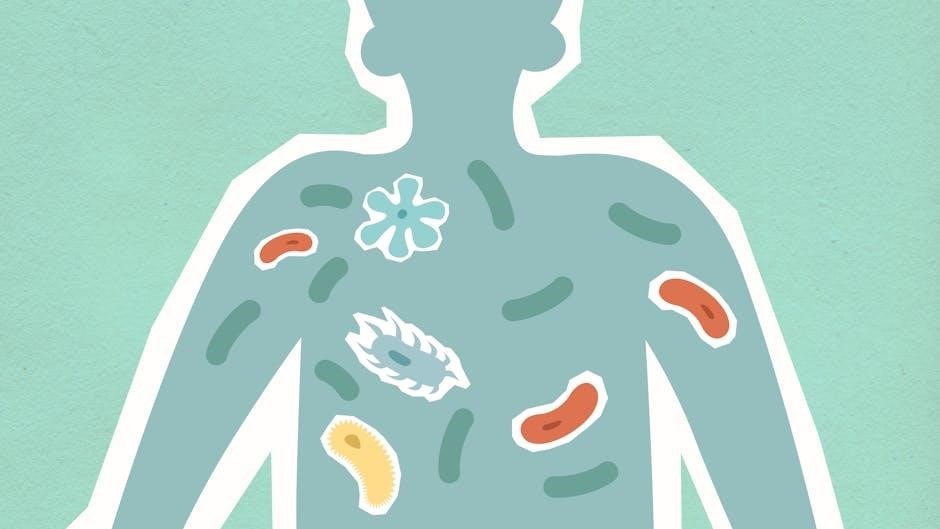transport across cell membrane pdf

transport across cell membrane pdf
The cell membrane is a semipermeable barrier regulating molecular movement, essential for cellular survival. Its transport mechanisms enable nutrient uptake, waste removal, and maintenance of internal balance, crucial for life.
1.1 Definition and Importance of Cell Membrane Transport

Cell membrane transport refers to the movement of molecules across the plasma membrane, enabling cells to exchange nutrients, waste, and signaling molecules. This process is vital for maintaining cellular homeostasis, regulating ion balance, and facilitating communication with the external environment. The cell membrane’s selective permeability ensures that only specific substances enter or exit, which is critical for proper cellular function. Transport mechanisms are essential for life, supporting processes like metabolism, growth, and responses to stimuli. Without efficient transport systems, cells would be unable to sustain their basic physiological needs, highlighting its central role in cellular survival and function.

1.2 Overview of Cell Membrane Structure and Function

The cell membrane is a dynamic, semipermeable structure composed of a phospholipid bilayer, embedded proteins, and cholesterol. This bilayer creates a hydrophobic barrier that regulates the movement of molecules. Proteins within the membrane, such as channels and transporters, facilitate the passage of specific substances. The membrane’s fluidity allows it to adapt to changing conditions while maintaining structural integrity. Its primary functions include controlling solute transport, signaling, and maintaining cellular homeostasis. The interplay between its structure and function enables selective permeability, ensuring essential molecules enter while harmful ones are excluded, thereby safeguarding cellular processes and overall health.

Types of Transport Across Cell Membrane
Transport across the cell membrane occurs via passive, active, and vesicular mechanisms, each serving distinct roles in maintaining cellular homeostasis and functionality.
2.1 Passive Transport
Passive transport facilitates the movement of molecules across the cell membrane without energy expenditure, driven by concentration gradients or diffusion. Simple diffusion allows small, non-polar molecules like oxygen and carbon dioxide to pass freely. Facilitated diffusion relies on membrane proteins to assist larger molecules, such as glucose, in crossing the membrane. Both processes maintain equilibrium and ensure essential nutrients and waste are exchanged efficiently, vital for cellular function and overall organismal health.

2.2 Active Transport
Active transport moves molecules against their concentration gradient, requiring energy, often from ATP hydrolysis. This process involves carrier proteins that bind to specific molecules, transporting them across the membrane. Unlike passive transport, active transport is essential for maintaining cellular homeostasis, enabling cells to accumulate necessary nutrients or expel harmful substances. Examples include the sodium-potassium pump and glucose transport in certain tissues. This energy-dependent mechanism ensures cells can regulate ion concentrations and maintain proper physiological functions, critical for overall cellular health and survival.
2.3 Vesicular Transport
Vesicular transport involves the movement of large molecules or particles across the cell membrane via membrane-bound vesicles. This process is essential for cells to internalize or expel bulky materials that cannot pass through membrane channels. Endocytosis and exocytosis are the primary forms of vesicular transport. In endocytosis, the cell membrane engulfs substances, forming vesicles that carry them into the cell. Conversely, exocytosis releases vesicle contents outside the cell. Both processes are energy-dependent and vital for cell signaling, nutrient uptake, and waste removal, ensuring efficient cellular communication and resource management.
Passive Transport Mechanisms
Passive transport relies on natural concentration gradients, moving molecules without energy. It includes simple diffusion and facilitated diffusion, allowing cells to efficiently exchange essential substances like oxygen and carbon dioxide.
3.1 Simple Diffusion
Simple diffusion is a passive transport mechanism where small, non-polar molecules like oxygen and carbon dioxide move freely across the cell membrane. This process occurs without the need for energy or membrane proteins, relying solely on concentration gradients. Molecules diffuse from areas of higher concentration to areas of lower concentration until equilibrium is reached. The lipid bilayer of the cell membrane facilitates this movement, allowing non-polar substances to pass through effortlessly. Simple diffusion is a continuous and essential process for maintaining cellular homeostasis, ensuring the exchange of vital gases and other small molecules necessary for survival.
3.2 Facilitated Diffusion
Facilitated diffusion is a passive transport mechanism that relies on carrier or channel proteins to move molecules across the cell membrane. Unlike simple diffusion, it requires the assistance of membrane proteins to facilitate the passage of polar or large molecules, such as glucose or ions. These proteins act as conduits or binding sites, enabling molecules to cross the membrane down their concentration gradient. Facilitated diffusion does not require energy (ATP) and is essential for substances that cannot freely diffuse through the lipid bilayer. It ensures efficient transport of vital nutrients and ions, maintaining cellular function and homeostasis.

Active Transport Mechanisms
Active transport is an energy-requiring process that moves molecules against concentration gradients using ATP and carrier proteins, crucial for cellular functions like nutrient uptake and ion balance.

4.1 Role of ATP in Active Transport
ATP plays a central role in active transport by providing the energy required to move molecules against their concentration gradient. This process involves ATP hydrolysis, where the energy from breaking down ATP is utilized by transport proteins embedded in the cell membrane. These proteins, such as pumps and carriers, use the released energy to drive the transport of ions or molecules. Without ATP, active transport would not be possible, making it essential for maintaining cellular homeostasis and proper ion balance across the membrane.
4.2 Examples of Active Transport Processes
Active transport involves energy-dependent processes crucial for cellular function. Key examples include the sodium-potassium pump, which maintains ion gradients essential for nerve impulses, and calcium pumps in muscle cells regulating contraction. Proton pumps in the stomach lining create an acidic environment for digestion. Additionally, glucose absorption in the intestines relies on active transport to uptake glucose against its gradient. Furthermore, drug efflux pumps in bacteria expel antibiotics, illustrating its diverse roles. These processes are vital for maintaining cellular homeostasis and enabling essential physiological functions.

Vesicular Transport Processes
Vesicular transport involves endocytosis and exocytosis, moving large molecules via membrane vesicles. These processes require energy and are crucial for cellular functions like nutrient uptake and waste removal.
5.1 Endocytosis
Endocytosis is a vesicular transport process where cells internalize molecules by engulfing them with a portion of the cell membrane, forming vesicles; This mechanism is essential for absorbing large molecules like proteins, hormones, and pathogens. It also facilitates cell signaling and nutrient uptake. Endocytosis can be receptor-mediated, ensuring specificity, and requires energy, often in the form of ATP. This process is vital for immune responses, as seen in phagocytosis, where cells engulf pathogens. Additionally, endocytosis helps regulate membrane components and maintain cellular homeostasis by recycling membrane proteins and lipids.
5.2 Exocytosis
Exocytosis is the process by which cells release molecules, such as hormones, neurotransmitters, and waste products, to the exterior by fusing vesicles with the cell membrane. This mechanism is crucial for cellular communication and secretion. Vesicles containing the material to be released migrate to the cell membrane, fuse with it, and discharge their contents. Exocytosis requires energy and is tightly regulated to ensure precise release. It plays a key role in processes like neuronal signaling, hormone secretion, and waste elimination, maintaining cellular and organismal function. This process also helps maintain membrane structure by recycling components back into the cell membrane.
Regulation and Energy Requirements
Cell membrane transport is tightly regulated to ensure proper energy allocation and molecular balance. Energy sources like ATP fuel active transport, while passive transport relies on gradients, optimizing efficiency and homeostasis.
6.1 Energy Sources for Transport Processes
Energy for transport across cell membranes is primarily derived from ATP, which is hydrolyzed to provide the necessary energy for active transport processes. This energy is crucial for moving molecules against their concentration gradient, ensuring essential nutrients and ions are transported into the cell. Additionally, secondary active transport systems utilize energy stored in electrochemical gradients, such as the sodium-potassium pump, which maintains ion balance. Passive transport, however, relies on concentration gradients and does not require direct energy input, making it an efficient means of molecular movement. Overall, the cell’s energy budget is carefully allocated to maintain transport efficiency and cellular homeostasis.
6.2 Regulation of Transport Across Membranes
The cell membrane regulates transport through selective permeability and specialized proteins. Channel proteins allow ions to flow, while carrier proteins facilitate diffusion and active transport. Pumps, like the sodium-potassium pump, maintain ion balance. Vesicular mechanisms, such as endocytosis and exocytosis, handle larger molecules. Concentration gradients and ATP availability influence transport efficiency. Feedback mechanisms and regulatory proteins ensure proper transport rates, maintaining cellular homeostasis. These systems adapt to environmental changes, optimizing nutrient uptake and waste removal. The membrane’s regulatory processes are crucial for cellular function and survival.
Medical and Biological Applications
Understanding transport mechanisms aids drug delivery, disease treatment, and insights into cellular physiology. Applications include targeted therapies, disease modeling, and developing medical interventions to enhance or inhibit molecular movement.
7.1 Role of Transport in Disease and Drug Delivery
Cell membrane transport plays a critical role in disease mechanisms and drug delivery systems. Diseases often arise from transport dysfunctions, such as ion channel disorders or impaired nutrient uptake. Drugs are designed to exploit transport mechanisms, like carrier proteins, to enter cells effectively. Targeted therapies, including nanoparticles and prodrugs, utilize membrane transport pathways to enhance delivery and reduce side effects. Understanding these processes aids in developing treatments for conditions like cancer, diabetes, and neurological disorders, improving therapeutic outcomes and patient care.
7.2 Implications for Cellular Physiology
Transport across cell membranes is vital for maintaining cellular homeostasis, enabling essential functions like nutrient uptake, waste removal, and ion balance. Proper transport mechanisms regulate intracellular environments, ensuring metabolic processes function optimally. Disruptions in membrane transport can lead to cellular dysfunction, contributing to diseases. Understanding these transport systems provides insights into cellular physiology, aiding in the development of therapies. Membrane transport also facilitates communication between cells and their surroundings, crucial for processes like nerve signaling and immune responses. Its dysregulation can impair tissue function, highlighting its central role in overall cellular health and survival.